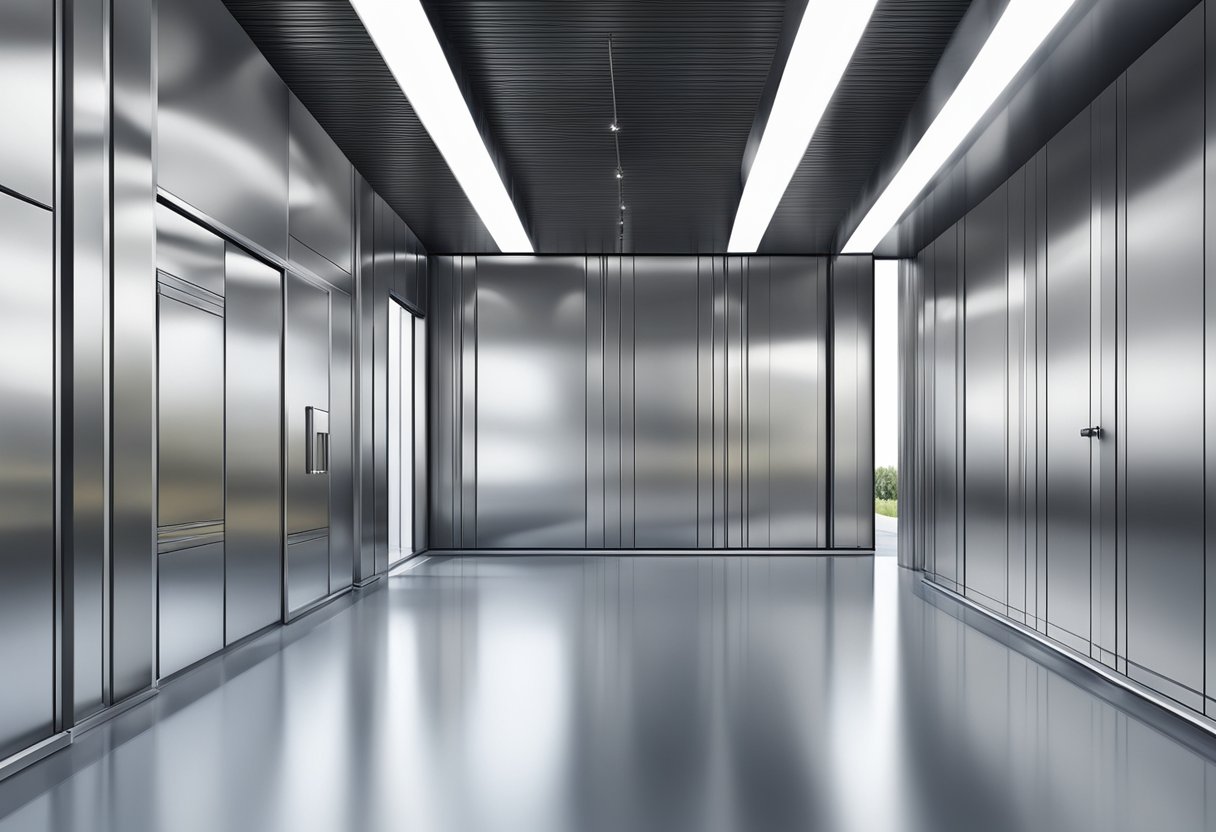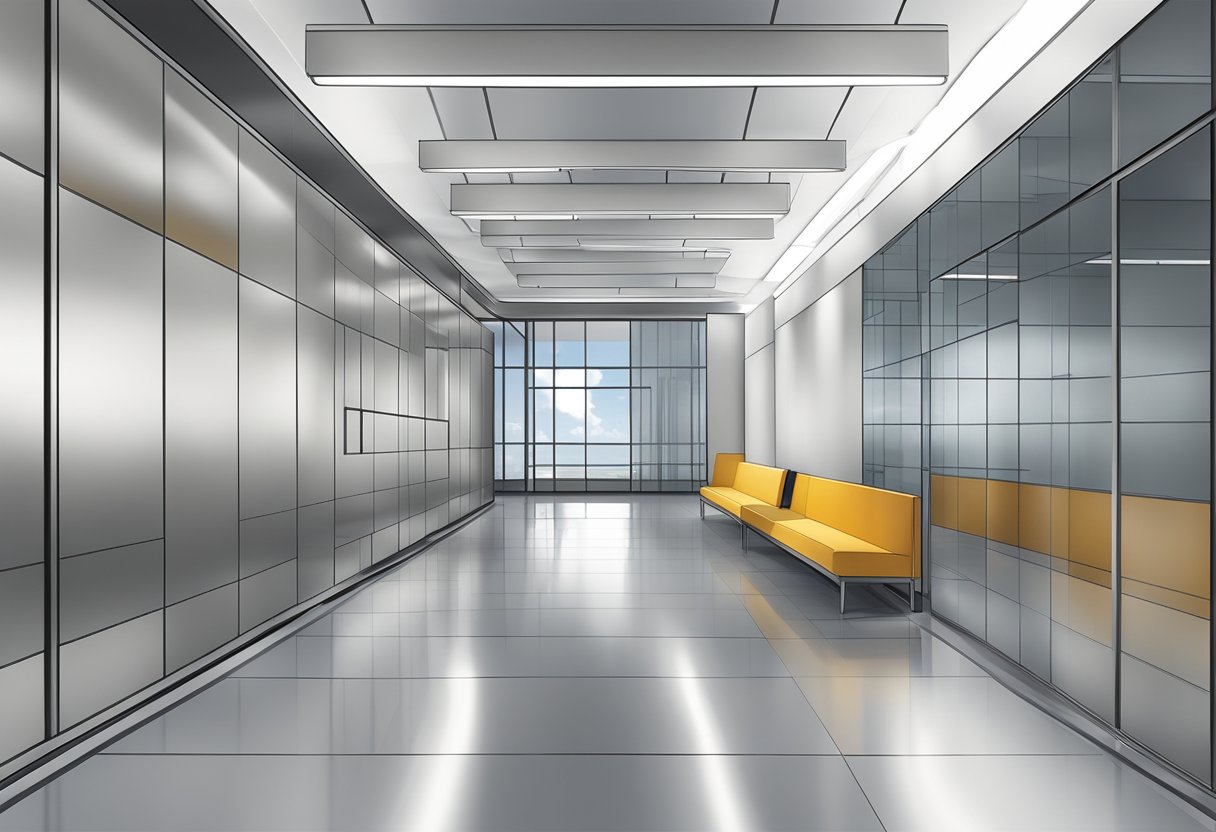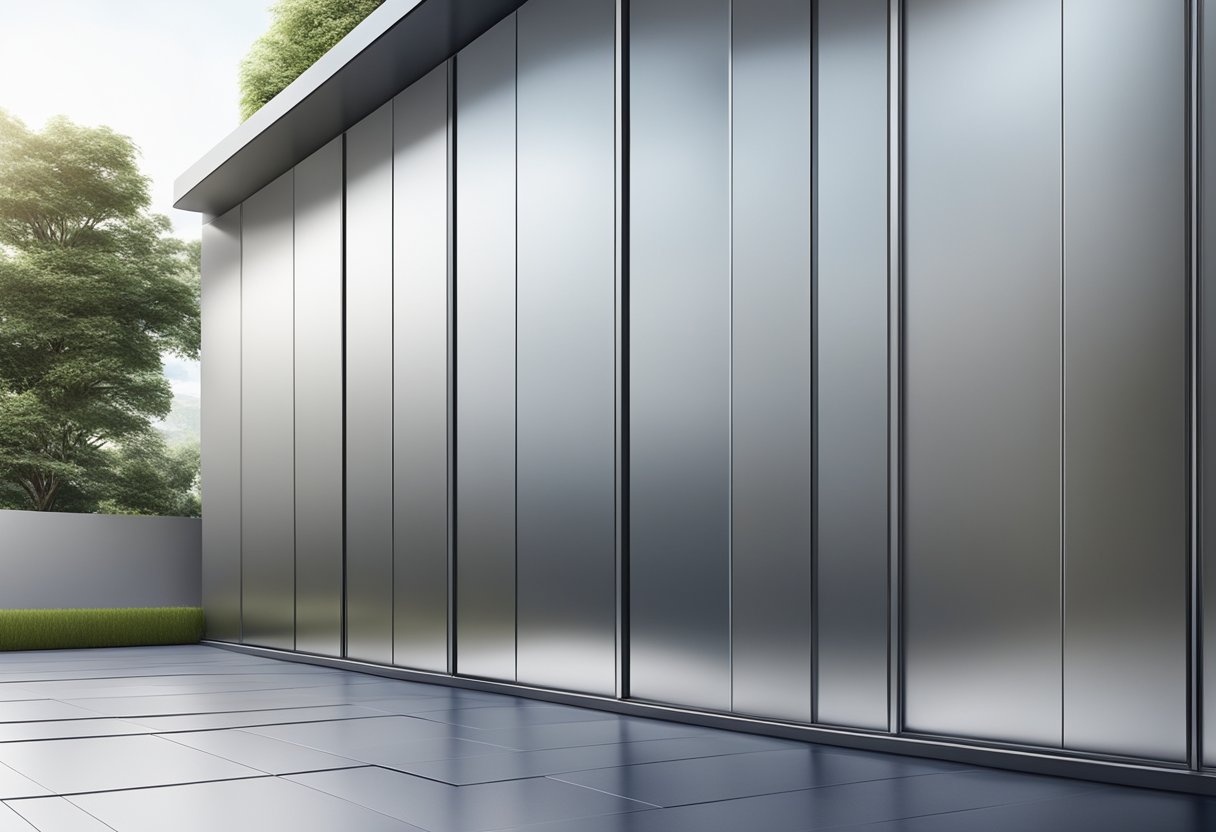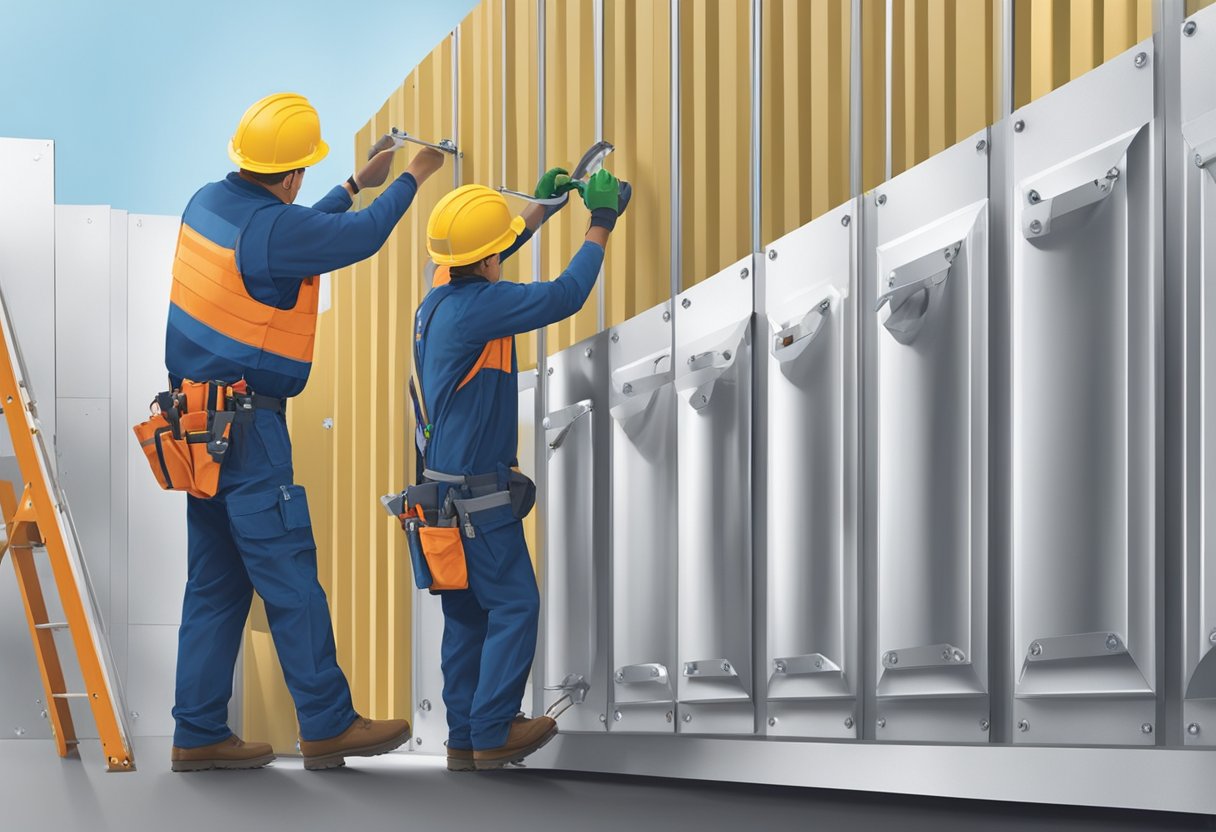Aluminum panel wall is a popular building material that has gained immense popularity in recent years. It is a lightweight, durable, and versatile material that is used to create a wide range of structures, including commercial buildings, residential homes, and industrial facilities. Aluminum panel walls are made of aluminum sheets that are sandwiched between two layers of non-aluminum material, such as plastic or foam.

One of the main advantages of using aluminum panel walls is that they are highly resistant to corrosion and rust. This makes them an ideal choice for buildings that are located in areas with high humidity or near the coast. Additionally, aluminum panel walls are easy to install and require minimal maintenance, which makes them a cost-effective option for building owners. The lightweight nature of aluminum panel walls also makes them easy to transport and install, which can save time and money during the construction process.
In conclusion, aluminum panel walls have become a popular building material due to their durability, versatility, and cost-effectiveness. They offer a range of benefits over traditional building materials and are suitable for a wide range of applications. As such, they are an excellent choice for anyone looking to construct a new building or renovate an existing one.
Aluminum Panel Wall Fundamentals

Composition and Properties
Aluminum panel walls are made up of two thin aluminum sheets, with a non-aluminum core in between. The core can be made of a variety of materials, including polyethylene, fire-retardant mineral-filled core, or honeycomb core. The aluminum sheets are typically coated with a high-performance coating to protect them from corrosion and weathering.
Aluminum panel walls are lightweight, durable, and have high strength-to-weight ratios. They are also easy to fabricate and install, making them a popular choice for modern construction projects.
Types of Aluminum Panels
There are several types of aluminum panels available, each with unique properties and applications. Some of the most common types include:
- Solid aluminum panels: These panels have a solid aluminum construction and are typically used for exterior cladding or decorative purposes.
- Composite aluminum panels: These panels have a non-aluminum core sandwiched between two aluminum sheets. They are lightweight and have excellent insulation properties, making them ideal for use in energy-efficient buildings.
- Perforated aluminum panels: These panels have small holes or perforations in them, allowing for ventilation and light transmission. They are often used as sunscreens or decorative elements.
Manufacturing Process
Aluminum panel walls are typically manufactured using a process called roll bonding. In this process, the aluminum sheets and core material are passed through a set of rollers, which bond them together under high pressure and temperature.
After bonding, the panels are cut to size and coated with a protective finish. The finished panels can then be fabricated into various shapes and sizes, depending on the needs of the project.
Overall, aluminum panel walls are a versatile and durable option for modern construction projects. With their lightweight construction, high strength-to-weight ratios, and easy installation, they are a popular choice for architects and builders alike.
Design Considerations

Aesthetic Aspects
When it comes to designing a building, the appearance of the exterior is just as important as the functionality of the interior. Aluminum panel walls offer a sleek and modern look that can be customized to fit any design aesthetic. The panels can be fabricated in a variety of colors, textures, and finishes, allowing architects to create a unique and visually appealing façade.
In addition to their customizable appearance, aluminum panels are also lightweight and easy to install, making them a popular choice for both new construction and retrofitting existing buildings.
Structural Integrity
While the aesthetic aspects of aluminum panel walls are important, their structural integrity is equally crucial. These panels are designed to withstand harsh weather conditions, including high winds, heavy rain, and extreme temperatures. They are also fire-resistant, making them a safe choice for buildings in areas prone to wildfires.
When designing a building with aluminum panel walls, it is important to consider the building’s location and the potential weather conditions it may face. Proper installation and maintenance are also key factors in ensuring the panels remain structurally sound for years to come.
Thermal Performance
In addition to their aesthetic and structural benefits, aluminum panel walls also offer excellent thermal performance. The panels can be insulated to help regulate the building’s temperature, reducing energy costs and increasing overall comfort for occupants.
When selecting insulation for aluminum panel walls, it is important to consider the R-value, or the measure of the insulation’s ability to resist heat flow. Higher R-values indicate better insulation performance, but also come at a higher cost. Architects and builders must weigh the benefits of increased insulation against the associated costs to determine the best option for each project.
Overall, aluminum panel walls offer a range of design and performance benefits that make them a popular choice for modern buildings. By considering the aesthetic aspects, structural integrity, and thermal performance of these panels, architects and builders can create visually stunning and functional structures that stand the test of time.
Installation Process

Tools and Materials
Before starting the installation process of the aluminum panel wall, it is important to gather all necessary tools and materials. The following list includes the essential items needed for the installation process:
- Aluminum panels
- Screws
- Drill
- Screwdriver
- Measuring tape
- Level
- Safety glasses
- Gloves
Step-by-Step Guide
To install an aluminum panel wall, follow these simple steps:
- Measure the area where the panels will be installed and mark the placement of the panels using a measuring tape and level.
- Drill holes in the aluminum panels where the screws will be placed.
- Place the panels onto the wall, lining up the holes with the marks made on the wall.
- Secure the panels to the wall using screws and a screwdriver. Make sure the panels are level and flush with the wall.
- Repeat the process until all panels have been installed.
Safety Protocols
It is important to follow safety protocols during the installation process to avoid any accidents or injuries. The following safety measures should be taken:
- Wear safety glasses to protect your eyes from debris and dust.
- Wear gloves to protect your hands from sharp edges and cuts.
- Use caution when handling the aluminum panels to avoid bending or damaging them.
- Use a ladder or scaffolding if necessary and make sure it is secure before climbing onto it.
By following these simple steps and safety protocols, the installation of an aluminum panel wall can be completed efficiently and safely.
Applications and Uses
Architectural Exteriors
Aluminum panel walls are widely used in architectural exteriors due to their durability and versatility. They can be used in a variety of building types, including commercial and residential buildings, hospitals, and schools. The panels are available in a range of colors and finishes, making them an attractive option for architects and designers. Additionally, aluminum panels are lightweight and easy to install, reducing construction time and costs.
Interior Design
Aluminum panel walls are also used in interior design applications, such as feature walls and ceiling panels. The panels can be customized to achieve a variety of design effects, including a sleek, modern look or a more traditional aesthetic. They can be installed in a variety of spaces, including lobbies, conference rooms, and retail spaces. The panels are also easy to clean and maintain, making them a practical choice for high-traffic areas.
Industrial and Commercial
Aluminum panel walls are commonly used in industrial and commercial applications due to their durability and resistance to corrosion. They are often used in food processing facilities, chemical plants, and other industrial environments where hygiene and cleanliness are critical. The panels can be customized to meet specific requirements, such as fire resistance or sound attenuation. Additionally, the panels are recyclable, making them an environmentally friendly option for industrial and commercial applications.
Overall, aluminum panel walls offer a versatile and practical solution for a variety of applications. Their durability, customization options, and ease of installation make them a popular choice for architects, designers, and builders.
Advantages of Aluminum Panel Walls
Durability
Aluminum panel walls are known for their durability. They are resistant to corrosion, weathering, and fire. This makes them ideal for buildings in areas with harsh weather conditions. Aluminum panels are also strong and can withstand impact, making them a good choice for high-traffic areas.
Sustainability
Aluminum panel walls are environmentally friendly. They are made from recycled materials and are recyclable themselves. This means that they can be reused and repurposed, reducing waste and conserving resources. Additionally, aluminum panels are energy-efficient, helping to reduce energy costs and the carbon footprint of a building.
Maintenance
Aluminum panel walls are low-maintenance. They require little upkeep and can last for decades without needing repairs or replacements. They are also easy to clean and can be washed with water and mild detergent. This makes them a cost-effective choice for building owners and managers.
In summary, aluminum panel walls offer several advantages over other building materials. They are durable, sustainable, and low-maintenance, making them a smart choice for any building project.
Challenges and Solutions
Corrosion Resistance
One of the main challenges faced with aluminum panel walls is their susceptibility to corrosion. Aluminum is a reactive metal, and when exposed to moisture and oxygen, it can corrode quickly. This can be especially problematic in areas with high humidity or near bodies of saltwater.
To combat this issue, manufacturers have developed various coatings and treatments to increase the corrosion resistance of aluminum panels. Some of these treatments include anodizing, which creates a protective oxide layer on the surface of the aluminum, and powder coating, which provides a durable and aesthetically pleasing finish.
Cost Factors
Another challenge with aluminum panel walls is their cost. Aluminum is generally more expensive than other materials commonly used for wall cladding, such as vinyl or wood. This can make it difficult for some projects to justify the cost of using aluminum panels.
However, it’s important to note that aluminum panels do offer several benefits that can offset their higher cost. For example, they are lightweight and easy to install, which can reduce labor costs. Additionally, they are highly durable and require minimal maintenance, which can save money over the long term.
Installation Challenges
Installing aluminum panel walls can also present some challenges. Due to their lightweight nature, they require a sturdy frame to support them. This can be especially difficult in areas with high wind loads or seismic activity.
To address this issue, manufacturers have developed specialized framing systems that are designed specifically for use with aluminum panels. These systems are engineered to provide the necessary support and stability to ensure a successful installation.
Overall, while aluminum panel walls do present some challenges, manufacturers have developed a variety of solutions to address these issues. By selecting the right coatings and treatments, balancing the cost with the benefits, and using specialized framing systems, aluminum panel walls can provide a durable and attractive solution for a wide range of applications.
Innovation and Trends
Technological Advancements
In recent years, the aluminum panel wall industry has seen significant technological advancements that have improved the performance and durability of these panels. One such advancement is the use of nanotechnology in the manufacturing process, which has led to the development of panels that are more resistant to weathering and corrosion. This has increased the lifespan of aluminum panel walls and reduced the need for frequent maintenance.
Another technological advancement is the use of computer-aided design (CAD) software, which has made it easier for architects and designers to create complex designs and patterns for aluminum panel walls. This has resulted in a wide range of unique and visually striking designs that were not possible before.
Emerging Designs
The use of aluminum panel walls has become increasingly popular in modern architecture due to their versatility and aesthetic appeal. As a result, many emerging designs are incorporating these panels in innovative ways. One such trend is the use of perforated aluminum panels, which can be used to create intricate patterns and designs that allow for natural light and ventilation while maintaining privacy.
Another emerging design trend is the use of colored aluminum panels, which can be customized to match the color scheme of a building’s exterior. This has led to a wide range of creative and unique designs that stand out in urban landscapes.
Market Growth
The aluminum panel wall market is expected to grow significantly in the coming years, driven by the increasing demand for sustainable and energy-efficient building materials. Aluminum panels are lightweight, durable, and recyclable, making them an ideal choice for green building projects.
The market is also being driven by the growing popularity of aluminum panel walls in the residential sector. Many homeowners are opting for aluminum panel walls as a way to add a modern and sleek look to their homes while also improving energy efficiency.
Overall, the aluminum panel wall industry is experiencing a period of rapid growth and innovation, driven by technological advancements, emerging design trends, and a growing demand for sustainable building materials.
Standards and Regulations
Building Codes
Aluminum panel wall systems are subject to building codes and regulations in order to ensure safety and quality. The International Building Code (IBC) is a widely adopted set of regulations in the United States that governs the design and construction of buildings. The IBC provides guidelines for the use of aluminum panel wall systems, including requirements for fire resistance, wind resistance, and structural performance.
Quality Standards
The quality of aluminum panel wall systems is regulated by various industry standards. The American Architectural Manufacturers Association (AAMA) provides standards for the performance and testing of architectural aluminum products, including panel wall systems. The AAMA 508 standard outlines the requirements for aluminum panel wall systems, including air infiltration, water penetration, and structural performance.
Environmental Compliance
Aluminum panel wall systems must also comply with environmental regulations. The production and use of aluminum can have a significant impact on the environment, including energy consumption and greenhouse gas emissions. The Aluminum Association has developed sustainability guidelines for the aluminum industry, which include reducing energy consumption and greenhouse gas emissions, increasing recycling rates, and promoting sustainable practices throughout the supply chain. Manufacturers of aluminum panel wall systems should strive to meet these guidelines in order to minimize their environmental impact.
Maintenance and Care
Cleaning Guidelines
To maintain the appearance and integrity of aluminum panel walls, it is important to clean them regularly. The frequency of cleaning will depend on the location of the panels and the amount of exposure to dirt and pollutants. In general, it is recommended to clean the panels at least twice a year.
To clean the panels, use a soft cloth or sponge with a mild detergent and warm water. Avoid using abrasive materials or harsh chemicals as they can damage the surface of the panels. Rinse the panels thoroughly with clean water after cleaning to remove any soap residue.
Inspection and Repair
Regular inspections of aluminum panel walls are essential to identify any damage or defects. Inspect the panels at least once a year for signs of corrosion, dents, or scratches. If any damage is found, it should be repaired promptly to prevent further damage.
Minor scratches or dents can be repaired using touch-up paint or filler. For more significant damage, it is recommended to consult a professional for repair or replacement.
Longevity Tips
Aluminum panel walls are durable and long-lasting, but proper maintenance is key to extending their lifespan. In addition to regular cleaning and inspections, there are a few tips to keep in mind:
- Avoid placing heavy objects against the panels, as this can cause dents or scratches.
- Keep vegetation away from the panels to prevent damage from roots or branches.
- Avoid using pressure washers to clean the panels, as this can damage the surface.
- If the panels are located near saltwater or in a corrosive environment, consider applying a protective coating to prevent corrosion.
By following these maintenance and care guidelines, aluminum panel walls can remain in excellent condition for many years to come.
Case Studies
Notable Projects
Aluminum panel walls have been used in a variety of notable projects, including the construction of the One World Trade Center in New York City, the Burj Khalifa in Dubai, and the Petronas Towers in Kuala Lumpur. These projects have demonstrated the durability and aesthetic appeal of aluminum panel walls, which have become increasingly popular in modern architecture.
Performance Analysis
Aluminum panel walls have been extensively tested for their performance in various weather conditions. Studies have shown that these walls are highly resistant to wind, rain, and extreme temperatures, making them an ideal choice for buildings located in areas with harsh climates. Additionally, aluminum panel walls have been found to be highly fire-resistant, which is an important consideration for building safety.
Client Feedback
Clients who have chosen to install aluminum panel walls in their buildings have reported high levels of satisfaction with the product. They have praised the durability and low maintenance requirements of the walls, as well as their aesthetic appeal. Additionally, clients have appreciated the flexibility that aluminum panel walls offer in terms of design options, as they can be customized to fit the specific needs of each project.
Overall, aluminum panel walls have proven to be a reliable and attractive choice for modern architecture, with a growing number of architects and clients choosing to incorporate them into their designs.



